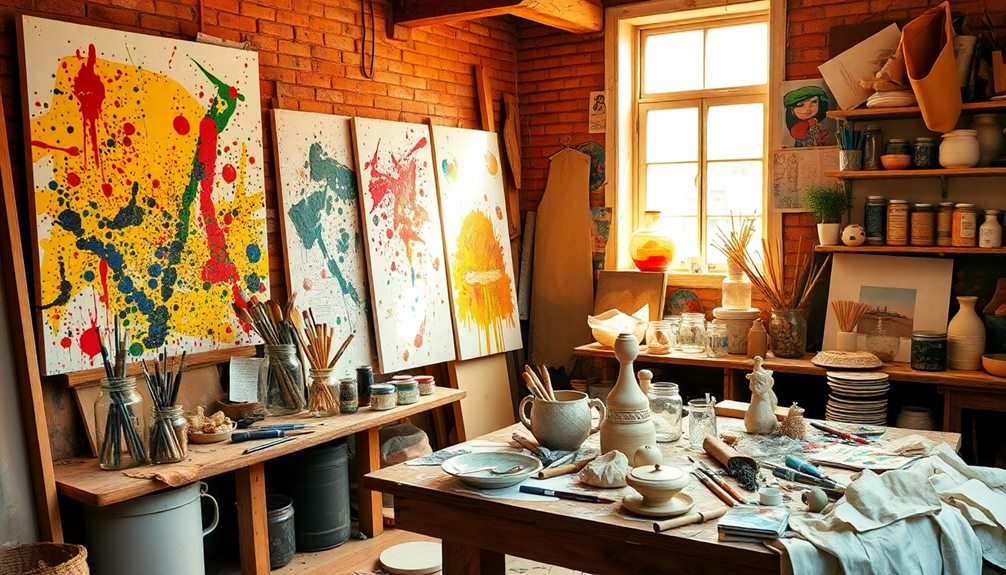Art conservation is fascinating work where skilled professionals use advanced techniques to preserve our cultural treasures. You'll see methods like laser cleaning, which removes dirt without harming the original materials. Conservators also analyze paint layers to understand an artwork's history and maintain its integrity. They rely on chemistry to choose safe solvents and guarantee treatments don't damage the piece. In dedicated facilities equipped with cutting-edge technology, they continually adapt practices for better results. This behind-the-scenes dedication guarantees artworks remain vibrant for future appreciation. Curious about the specific techniques and challenges conservators face? There's much more to explore.
Key Takeaways
- Art conservation employs advanced techniques like laser cleaning, which effectively removes dirt while preserving original materials without damage.
- Understanding the artist's background and historical context is crucial for informed conservation decisions and preserving the integrity of artworks.
- Paint layer analysis allows conservators to examine artistic techniques and previous restoration efforts, aiding in appropriate conservation methods.
- Chemistry plays a significant role in preservation, helping identify material composition and ensuring safe treatment methods to prevent harm.
- Continuous learning and adaptation in conservation practices enhance visitor engagement and appreciation for the intricacies of artworks.
Conservation Techniques Overview
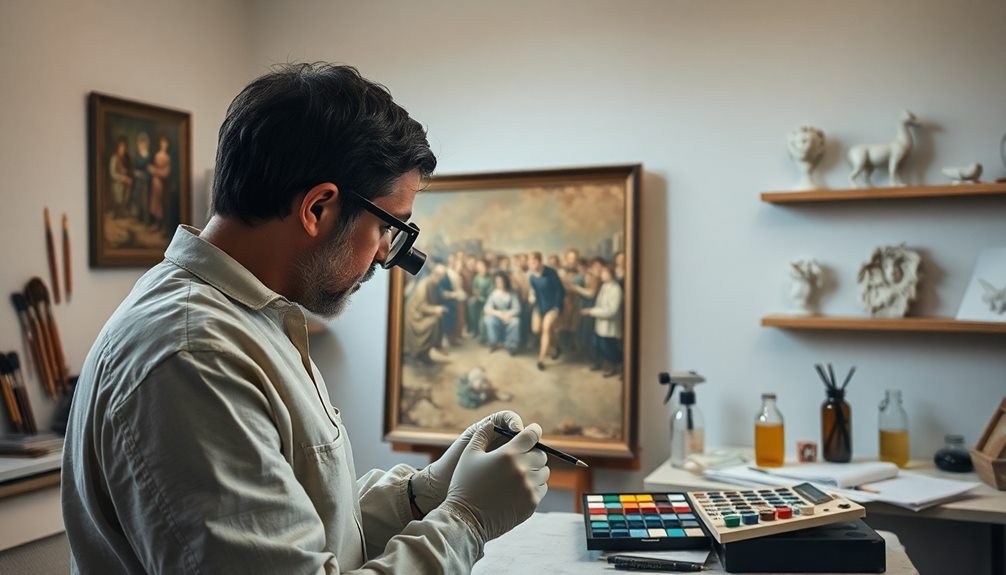
When it comes to art conservation, professionals often turn to a blend of traditional and modern techniques to preserve valuable pieces. One notable method is laser cleaning, which effectively removes dirt and grime without harming the original materials. This precision guarantees that the artwork's integrity remains intact throughout the process.
In addition to laser cleaning, conservators often use traditional methods, such as applying solvents followed by fish glue for paint consolidation. This combination helps maintain the original aesthetics while guaranteeing durability.
During the conservation process, a heated spatula is sometimes employed to relax paint layers, allowing for careful manipulation and restoration.
It's important to understand that significant restoration efforts can take up to a year, reflecting the extensive time and dedication involved. Throughout this period, monitoring the loss of paint is essential. This vigilance prevents further deterioration and ensures the artwork's longevity.
Historical Significance of Art

When you explore the historical significance of art, consider how the artist's background and the time period shape their creations.
Analyzing the layers of paint reveals not just techniques but also the evolution of styles that reflect cultural values.
Understanding these elements helps you appreciate the deeper context and meaning behind each artwork.
Artist's Background Influence
Understanding an artist's background can really shed light on their historical significance and the choices they made in their work. When you explore the early 16th-century artist's training and influences, you uncover vital details that explain their stylistic choices and techniques in sculpture. This context not only enriches your appreciation of the artwork but also aids conservators in their efforts.
Knowledge of the cultural and historical landscape during the artist's time allows you to interpret the materials and methods used in creating the piece. For instance, analyzing paint layers can reveal insights into the artist's palette and application techniques, showcasing the evolution of their style.
Furthermore, documentation of the artist's biography and artistic environment informs the conservation approaches taken, ensuring that any treatments align with the integrity of the original work. Recognizing the significance of the artist's contributions to their field helps prioritize conservation efforts, preserving their legacy for future generations.
Time Period Considerations
The historical importance of a piece of art is deeply intertwined with the time period in which it was created. When you examine an early 16th-century sculpture from the Renaissance, you see how the artistic techniques and materials of that era shape its conservation approach.
Understanding this context is vital for determining the most appropriate restoration methods, as each period has its unique artistic goals and compositions.
As you explore conservation, consider how the loss of paint must be carefully monitored. This vigilance is essential to prevent further deterioration and to maintain the artwork's integrity, especially for pieces from specific historical periods.
The materials and techniques used by artists during the Renaissance differ greatly from those of later eras, which influences your conservation decisions.
Knowledge of the artwork's historical importance helps guarantee that your treatments align with the artist's original intent and the cultural value of the piece.
Paint Layer Analysis
In examining early 16th-century sculptures, analyzing the paint layers reveals not just the artist's techniques but also the broader historical context that shaped their work. By closely studying these layers, you uncover vital insights into the materials and methods used by artists of that era, shedding light on the evolution of artistic practices.
Through this detailed examination, you can identify previous restoration efforts and the original color palette, which aids in making informed conservation decisions. Understanding the chemical composition of the paint layers allows you to pinpoint deterioration processes, enabling you to select the most appropriate conservation methods.
Monitoring the loss of paint layers is essential to prevent further deterioration and maintain the sculpture's historical integrity. Microscopic analysis of paint samples provides a detailed view of layering techniques and the interactions between different materials, contributing to a thorough understanding of the artwork's history.
Chemistry's Role in Preservation
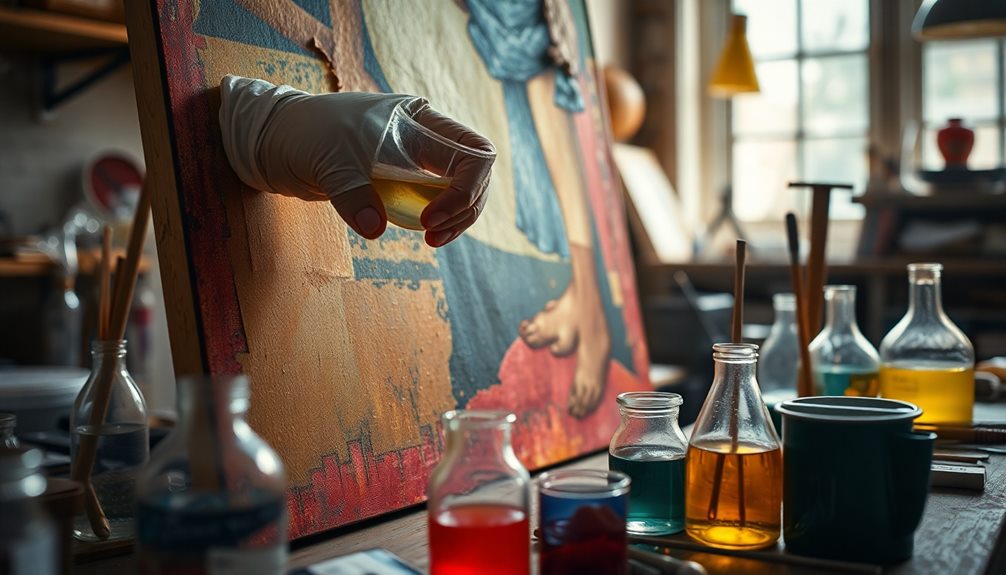
Chemistry opens the secrets of art conservation, revealing the material composition of artworks vital for effective preservation. By analyzing paint samples under a microscope, you gain insights into the layering and deterioration processes, allowing you to monitor loss and prevent further damage. This understanding is essential when selecting appropriate treatment methods.
As you observe chemical interactions during treatment processes, you guarantee that the methods used won't harm the artwork while effectively addressing deterioration. Your knowledge of solvents and their effects on different materials helps you choose safe techniques. For example, using fish glue for paint consolidation aligns with the chemical properties of the artwork, minimizing risks.
Innovative technologies, like laser cleaning, show how chemical principles can be applied in conservation. Originally designed for medical applications, this technique allows you to safely remove dirt and restore artworks without damaging the underlying materials.
Facilities for Conservation Work
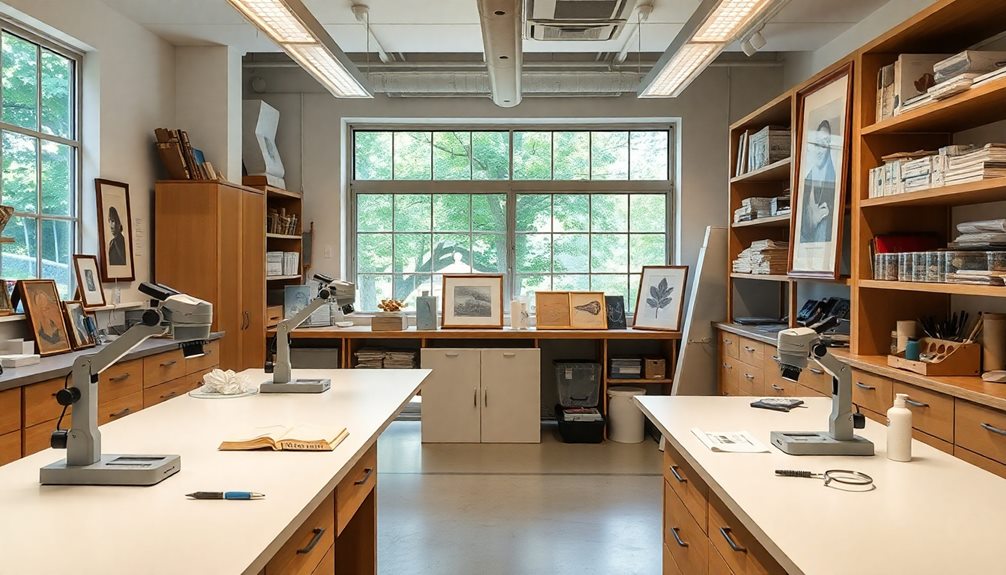
Frequently, conservation facilities like those at the Gardener Museum showcase cutting-edge technology and innovative methods crucial for preserving artworks. You'll find that the museum employs laser cleaning techniques, initially developed for medical uses like tattoo removal, to effectively target dirt and grime on marble surfaces. This approach allows conservators to restore artworks with precision, guaranteeing the integrity of the original pieces remains intact.
Equipped with advanced tools, the facilities enable conservators to analyze paint samples under a microscope. This detailed analysis helps them understand the composition and deterioration of the materials used, informing their restoration strategies.
Additionally, the quiet operation of the laser equipment minimizes disruption during restoration work, enhancing your experience as a visitor. You can appreciate the intricate details of the artwork without the distraction of noisy machinery.
The Gardener Museum's commitment to ongoing learning and adaptation in conservation techniques keeps its facilities at the forefront of art preservation efforts. By continually integrating new methods and technologies, they guarantee that the artworks are cared for with the utmost expertise, maintaining their beauty for future generations to enjoy.
Laser Technology in Art Care
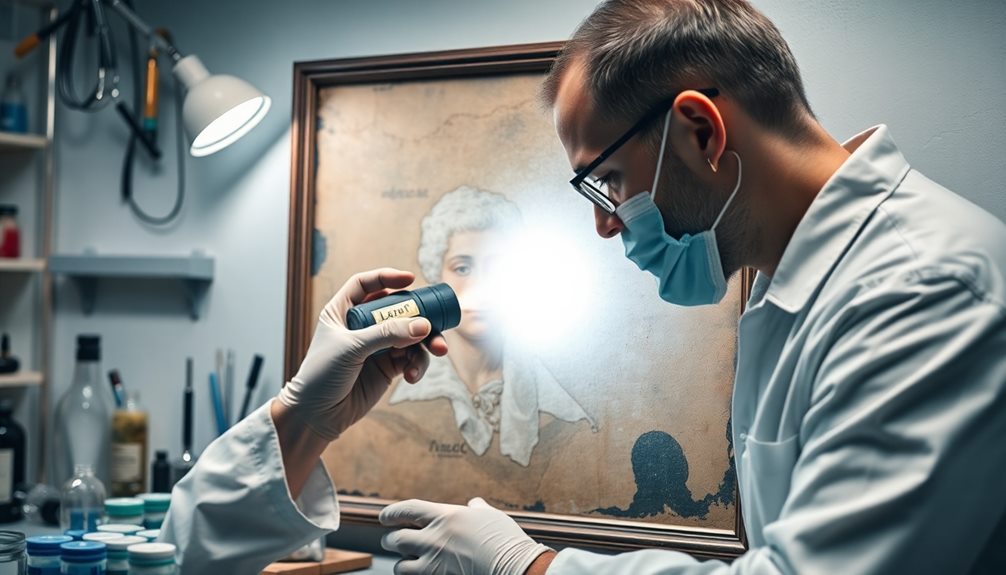
Laser technology is changing the way you think about art conservation by allowing for precision in dirt removal.
With its ability to target contaminants without harming the artwork, it enhances the visibility of intricate details like grapevines and muscle definition.
This method not only preserves the integrity of the pieces but also enriches your appreciation of the art itself.
Precision in Dirt Removal
Utilizing cutting-edge laser technology, conservators have revolutionized the way dirt and grime are removed from delicate artworks. At the Gardner Museum, they employ lasers originally designed for medical applications, ensuring that the cleaning process is both effective and safe. This innovative method uses energy beams that target dirt on marble, allowing for a precise and focused approach to conservation.
Additionally, just as with wood stove safety, adhering to proper protocols during the cleaning process is essential to prevent damage to the artworks safety standards and regulations.
As you observe the process, you'll notice how quiet and efficient it is, letting conservators concentrate on areas they've already cleaned without disturbing the artwork. This precision reveals intricate details like grapevines and muscle definition, enhancing the visual experience for visitors like you.
Moreover, this laser cleaning technique marks a significant advancement in conservation methods. By merging traditional techniques with modern innovations, conservators can provide ideal care for treasured artworks.
The ability to clean without damaging underlying materials is a game-changer, ensuring that each piece remains vibrant and true to its original form. As the technology continues to evolve, you're witnessing a new era in art conservation that prioritizes both preservation and accessibility.
Enhancing Artwork Visibility
The Gardener Museum's innovative approach to art conservation has transformed how you experience the intricate details of artworks. By employing pioneering laser technology originally designed for medical use, conservators effectively enhance visibility by removing dirt and grime from marble surfaces. This technique delivers significant improvements in the way you see artworks, revealing details often hidden from view.
Here are three key benefits of using laser technology in art care:
- Precision Cleaning: The energy beams selectively target contaminants, allowing for a gentle removal process that doesn't harm the underlying artwork.
- Increased Detail Visibility: With layers of dirt eliminated, you can now appreciate intricate features like grapevines and muscle definition that were once obscured.
- Quiet Operation: The laser operates silently, enabling conservators to work without disrupting the experience of other visitors or affecting nearby artworks.
Thanks to these advancements, you'll find that the enhanced visual experiences resulting from laser conservation efforts have garnered positive feedback from frequent museum-goers.
This highlights the importance of this cutting-edge technique in preserving art for future generations.
Visitor Experience Enhancement

Art conservation at the Gardener Museum transforms each visit into a richer experience by revealing the intricate details of masterpieces that were once hidden. Using pioneering laser technology, the museum effectively removes dirt and grime, enhancing the visual appeal of the artworks. You'll find that the restoration of intricate details, like grapevines and muscle definition, deepens your appreciation for the pieces on display.
The museum's commitment to conservation not only preserves these treasures but also enriches your experience. As you explore, you'll notice how layers of dirt or paint loss have been skillfully addressed, revealing aspects you might have missed before. Frequent visitors often share positive feedback, highlighting the impact of these conservation practices on their overall engagement and enjoyment.
Here's a quick overview of how conservation enhances your visit:
| Visitor Impact | Conservation Technique |
|---|---|
| Improved appreciation | Laser technology for cleaning |
| Enhanced visual details | Restoration of intricate elements |
| Deeper engagement | Uncovering hidden features |
| Continuous adaptation | Ongoing learning in conservation |
This dedication guarantees that artworks remain in their best possible condition for your enjoyment.
Ongoing Learning in Conservation

In the domain of conservation, professionals are constantly expanding their knowledge to refine their restoration techniques. This commitment to ongoing learning is vital because it helps conservators adapt to new challenges and technologies.
They're not just preserving art; they're evolving their skills to enhance their practices. Here are three key ways they achieve this:
- Studying Historical and Modern Techniques: By analyzing methods like the laser cleaning pioneered at the Gardener Museum, you can understand how to blend the old with the new for effective restoration.
- Microscopic Analysis of Paint Layers: Examining the layers of paint under a microscope reveals essential insights into the materials and techniques artists used, enabling you to replicate historical fidelity in restorations.
- Applying Chemistry: Understanding chemical processes behind deterioration allows you to safely treat artworks without inflicting damage, guaranteeing longevity and integrity.
Through regular feedback from visitors and collaborative workshops, conservation professionals not only enhance their skills but also make certain their methods resonate with the public's appreciation of art.
This dedication to learning keeps the field dynamic and responsive to emerging needs.
Frequently Asked Questions
What Are the Steps of Art Conservation?
To conserve art, you start by examining the piece, then use laser cleaning to remove dirt. Next, apply solvents and fish glue, and manipulate paint layers carefully to guarantee the artwork's integrity is preserved.
How Hard Is It to Become an Art Conservator?
Becoming an art conservator's tough. You'll need a master's degree, extensive training in chemistry and conservation techniques, and a keen eye for detail. It demands dedication, patience, and a deep appreciation for art history.
What Degree Is Needed to Be an Art Restorer?
You'd think a simple degree suffices, right? Well, to be an art restorer, you'll need at least a bachelor's in art conservation or fine arts. Advanced degrees and hands-on training are essential for success.
What Is the Difference Between an Art Restorer and an Art Conservationist?
An art restorer focuses on repairing damaged artworks, while an art conservationist prioritizes long-term preservation. You'll find restorers using techniques like cleaning and repainting, whereas conservationists analyze materials to prevent deterioration over time.
Conclusion
In the world of art conservation, you're not just preserving history; you're actively engaging with it. Did you know that nearly 60% of artworks in museums require some form of conservation? That's a staggering number, highlighting the ongoing need for skilled professionals in this field. By embracing innovative techniques like laser technology and chemistry, you're ensuring that these treasures can be enjoyed for generations to come. Your role in this process is essential, making art more accessible and vibrant.

